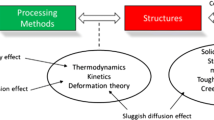Conclusion
The stability of austenite under strain can be increased by programmed loading in the temperature range where the stability of heated austenite is highest and the diffusion mobility of lattice defects is adequate. For some parts of austenitic steels (of the Kh18NI0T type) operating at low temperatures under stress, programmed loading can be used as the final treatment.
Similar content being viewed by others
Literature cited
G. V. Kurdyumov and O. P. Maksimova, Dokl. Akad. Nauk SSSR,73, No. 1 (1950).
R. I. Garber et al., Metal, i Term. Obrabotka Metal., No. 5 (1967).
R. I. Garber et al., Zavod, Lab., No. 5 (1962).
I. A. Gindin et al., in: Some Problems of Strength in the Solid State [in Russian], Izd. AN SSSR (1959).
R. I. Garber et al., Fiz. Metal. Metalloved.,18, No. 3 (1964).
V. Ya. Il'ichev, Metal, i Term. Obrabotka Metal., No. 10 (1966).
Additional information
Physicotechnical Institute of the Academy of Sciences, Ukrainian SSR. Translated from Metallovedenie i Termicheskaya Obrabotka Metallov, No. 6, pp. 71–72, June, 1970.
Rights and permissions
About this article
Cite this article
Gindin, I.A., Lavrinenko, I.S. & Neklyudov, M. Increasing the stability of austenite by programmed loading. Met Sci Heat Treat 12, 533–535 (1970). https://doi.org/10.1007/BF00668873
Issue Date:
DOI: https://doi.org/10.1007/BF00668873




